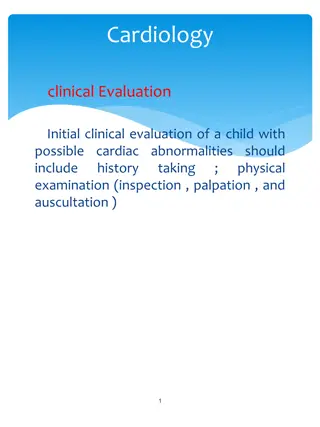Rapid Assessment of Newborn Care: Essential Steps and Interventions
Detailed information on the initial steps of newborn care, including assessing the need for additional interventions, managing conditions like persistent cyanosis and labored breathing, using a Pulse Oximeter, providing supplemental oxygen, and when to consider Positive Pressure Ventilation. Practic
0 views • 27 slides
Understanding Cyanosis: Causes, Types, and Clinical Differentiation
Cyanosis is characterized by a bluish discoloration of the skin and mucous membranes due to increased levels of reduced hemoglobin. This condition can be categorized as central or peripheral cyanosis, each with distinct characteristics and causes. Central cyanosis results from decreased oxygen satur
0 views • 13 slides
Comprehensive Clinical Evaluation of Children with Cardiac Abnormalities
Initial clinical evaluation of a child with possible cardiac abnormalities includes history taking and physical examination. History should cover symptoms related to pulmonary and systemic venous congestion, cyanosis, cyanotic spells, palpitations, chest pain, and more. The general physical examinat
0 views • 65 slides
Causes and features of cyanotic congenital heart disease
This informative content covers the causes and features of cyanotic congenital heart disease, including central cyanosis due to congenital heart diseases like Tetralogy of Fallot, pulmonary atresia, Ebstein anomaly, and more. It also discusses non-cardiac causes of cyanosis related to lung diseases,
0 views • 41 slides
Pediatric Respiratory Infections: An Overview of Cases and Physiology
This review delves into selected cases of respiratory infections in children presented by Dr. David L. Smith, focusing on the anatomical and physiological aspects of the pediatric airway and respiratory system. It discusses respiratory failure in infants and small children, metabolic demands, cyanos
0 views • 49 slides
Understanding Shock: Types, Classification, and Clinical Course
Shock is a critical state where the circulatory system fails to adequately perfuse cells, leading to oxygen and nutrient delivery reduction. It can be classified into hypovolemic, cardiogenic, and distributive types, with septic shock caused by microbial infections. Shock progresses through stages f
0 views • 8 slides
Ascites in Broiler Chickens: Causes, Symptoms, and Management
Ascites is a common disease in broiler chickens, especially at high altitudes. It is characterized by fluid accumulation in the peritoneal cavity or pericardial sac, often containing yellow protein clots. Predisposing factors include reduced ventilation, high altitude, and respiratory disease. Sympt
0 views • 13 slides
Understanding Oxygen Inhalation in Medical Treatment
Oxygen inhalation is a vital medical intervention to treat low blood oxygen levels in children with respiratory issues. It helps manage hypoxia, maintain oxygen levels in the blood, and support normal cellular function. Common indications include cyanosis, breathlessness, anemia, and exposure to low
0 views • 44 slides
Overview of Cyanotic Congenital Heart Diseases (CCHD)
This content provides detailed information and images on various types of Cyanotic Congenital Heart Diseases (CCHD) including CCHD with low PBF, CCHD with high PBF, TOF equivalents, Eisenmenger syndrome, inter-circulatory mixing, and more. It explores causes of cyanosis, classifications based on phy
0 views • 16 slides








